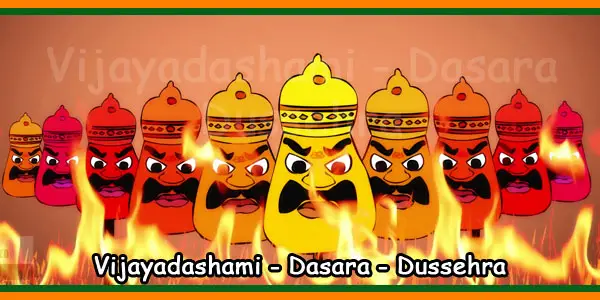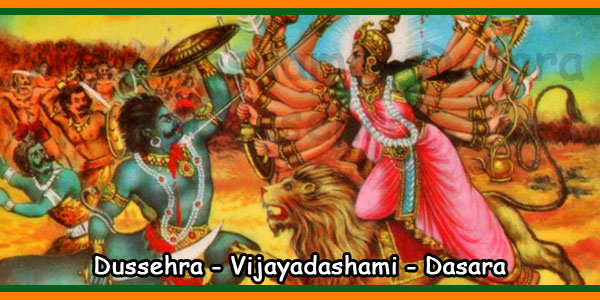Vijayadashami is celebrated to commemorate the victory of Lord Rama over Demon Ravana. Vjayadashami also marks the triumph of Goddess Durga over the buffalo Demon Mahishasura. Vijayadashami is also popularly known as Dussehra or Dasara. In Nepal, Dashain is its name.
Rituals like Shami Puja, Aparajita Puja and Seema Avalanghan are followed on the day of Vijayadashami. As per Hindu division of the day, these rituals should be performed during Aparahna time.

Bengal Vijayadashami/Dasara/Dussehra:
Vijayadashami day of West Bengal is not always the same as that of other states in India. It happens one day after the Vijayadashami in other states.
Vijayadashami is observed in most Indian states based on appropriate Muhurata and the day is chosen when there is the right combination of Tithi and Nakshatra during afternoon. Hindu religious texts suggest observing Vijayadashami only after considering appropriate Muhurata.
It seems that West Bengal has moved slowly away from the above rule as it is noted that they prefer Dasami Tithi only to observe Vijayadashami, without considering appropriate Muhurata.
Vijayadashami is celebrated to commemorate the victory of Lord Rama over Demon Ravana. Vjayadashami also marks the triumph of Goddess Durga over the buffalo Demon Mahishasura. Vijayadashami is also popularly known as Dussehra or Dasara. In Nepal, it is called Dashain
Vijayadashami/Dasara/Dussehra History:
Dasara marks the festivity of all age groups to celebrate. From children to elders, all will participate in the Dussehra celebrations. There are two important stories behind Vijaya Dashami celebrations. One story is associated with Lord Ram, and another is associated with Goddess Durga. The festival of Dashain signifies the victory of good over evil. The statutes of Ravana, Kumbhakarna and Indrajit, are burned signifying as Rama’s victory.
According to the great Hindu epic Ramayana, Lord Ram killed Ravana on the tenth day that is Dussehra. Ravana is said to have abducted Ram’s wife, Sita. The end of Ravana’s rule meant the end of bad and evil spirit as he was a demon by birth too.
Throughout Navaratri, Ramleela is organised in many northern parts of the country, and people enjoy the enactment of the play based on Ramayana.
Another legend connected to Goddess Durga is, the Mahishasura who is a demon king and more powerful. He was undefeatable by Lord Brahma, Lord Vishnu and Lord Siva. Therefore, all the gods create Goddess Durga to destroy Mahishasura. Goddess Durga, an avatar of Maha Sakthi, fought with the demon king and defeated him.
Her victory over Mahishasura is celebrated as Vijaya Dashami or Dussehra by many people following Hinduism.
In South India, the nine days preceding Dussehra have been equally divided for worshipping the nine avatars of Goddesses Durga. The women and the children of Tamil Nadu, Andhra Pradesh and Karnataka arrange small statues like dolls, known as ‘Bommai (Bommala) Kolu’, on artificial steps and decorate the steps and the nearby place with beautiful lamps and flowers.
Another story from the epics connected to the origin of Dussehra from the greatest Hindu epic, Mahabharata. Kauravas banished Pandavas for 12 years and one year disguise because of Dharmaraj was defeated by Kauravas in the gambling.
Pandavas decided to live in exile in the woods for 12 years and one year in disguise. They have hidden their weapons under the Shami tree. For every one year in the ending, they visit the Shami tree and worship it and Goddess Durga. Pandavas fought over Kauravas and emerged victory. This has happened on Dashami. And ever since, the good had achieved victory over evil, and it is marked as Vijaya Dashami.
There are many other epic stories associated with the festival of Dussehra. No matter what the stories are, festivals in India convey the message of kindness, peace and love.

Vijayadasami different Names:
1) Dashahara
2) Dussehra
3) Dashain
4) Navaratri
5) Durgotsav
6) Dasara
7) Vishwakarma Diwas
Rituals of Vijayadashami in Different States:
In the north of India, Vijaya Dashami is celebrated as Ramlila. On this day, large effigies of Ravana, his brother Kumbhakarna and his son Meghnath are burned in large fairs in front of large crowds of spectators. These effigies are filled with various types of crackers and theaters take place depicting the story of how Lord Rama won the victory over Ravana that day.
In southern India, this day marks the end of Golu — a festival held in Tamil Nadu, Karnataka and Kerala. The god Durga is worshiped in the form of Devi Chamundeshwari during this phase.
In addition, children are introduced to formal education in schools this day. This is preceded by the cult of books on Navami Day. This pooja is known as Ayudha puja.
In some areas of Andhra Pradesh, there is an ancient custom of giving Shami leaves to the elderly as a mark of respect. Other important events include Theppotsavam: the festival of the boat that is celebrated during this period on the Krishna River.
In Kerala, Vidyarambham is celebrated on this day when young children are introduced to formal education, which makes them to write their name in a rice dish with the help of a elder member of the family.
In West Bengal, this day is celebrated as the last day of Durga Puja. Idols of Goddess Durga are immersed in the water thus marking the Goddess’s homeward journey to Kailash.

